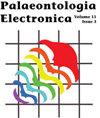A large, pathological skeleton of Smilosuchus gregorii (Archosauriformes: Phytosauria) from the Upper Triassic of Arizona, U.S.A., with discussion of the paleobiological implications of paleopathology in fossil archosauromorphs
IF 1.5
4区 地球科学
Q1 Earth and Planetary Sciences
引用次数: 4
Abstract
Phytosaurs were a widespread clade of Triassic predatory archosauriforms whose skull anatomy is well known, but whose paleobiology is underexplored. Here we report on a well-preserved specimen from Adamanian (early–mid-Norian) strata in Arizona that includes not only the skull and lower jaws but much of the postcranial skeleton, which exhibits extensive evidence of pathologies. This specimen has a complex taxonomic history, and we verify its referral to Smilosuchus gregorii based on multiple cranial characters. The shafts of eight limb bones preserve extensive exostoses—more paleopathological elements than in any other Triassic archosauromorph. These exostoses are often centered on cavitations reminiscent of draining tracts. Extensive, irregular, proliferative lesions have completely engulfed the left deltopectoral crest and thoroughly altered the architecture of both femora. The animal’s presumed low metabolic rate would have allowed several months of lesion progression before it died of either nutritional deficiency or systemic infection. This is the fourth, and by far the most extensive, report of pathology in a phytosaur, and only the eighth in a non-dinosaurian Triassic archosauromorph. The character and location of the lesions evokes aspects of both osteomyelitis and hypertrophic osteopathy—though neither is fully consistent with the changes present, nor are these conditions well-explored in extant reptiles. The most likely cause of the pathologies exhibited here is osteomyelitis; indeed, this specimen bears more osteomyelitis-like paleopathological elements than any other fossil archosaur. Andrew B. Heckert. Department of Geological and Environmental Sciences, Appalachian State University, ASU Box 32067, Boone, North Carolina 28608-2067 USA. heckertab@appstate.edu Tabitha C. Viner. USFWS National Fish and Wildlife Forensic Laboratory, 1490 E. Main St. Ashland, Oregon 97520, USA. tabitha_viner@fws.gov Matthew T. Carrano. Department of Paleobiology, P.O. Box 37012, MRC 121, Smithsonian Institution, Washington, DC 20013-7012, USA. carranom@si.edu HECKERT, VINER, & CARRANO: PATHOLOGICAL PHYTOSAUR 2美国亚利桑那州上三叠世格里高利剑龙(原蜥脚类:植物蜥脚类)的大型病理骨架,并讨论了原蜥脚类化石中古病理学的古生物意义
植龙是三叠纪掠食性始龙类的一个广泛分支,其头骨解剖结构众所周知,但其古生物学尚未得到充分研究。在这里,我们报告了一个保存完好的标本,它来自亚利桑那州的Adamanian(早-中- norian)地层,不仅包括头骨和下颚,还包括大部分颅后骨骼,这显示了广泛的病理证据。该标本具有复杂的分类学历史,我们根据多个颅骨特征验证了其与gregorii Smilosuchus的关系。八根肢骨的骨轴保存了大量的外骨骼——比任何其他三叠纪始祖恐龙都要多。这些外生瘤通常以空洞为中心,类似于排水道。广泛、不规则、增殖性病变已完全吞没左三角胸峰,并彻底改变了双股的结构。据推测,这只动物的代谢率很低,在它死于营养缺乏或全身性感染之前,可能会有几个月的病变进展。这是第四份,也是迄今为止最广泛的一份关于植龙病理的报告,而在非恐龙的三叠纪原龙中只有第八份。病变的特征和位置让人联想到骨髓炎和肥厚性骨病——尽管两者都不完全符合目前的变化,也没有在现存的爬行动物身上得到充分的研究。最可能的病因是骨髓炎;事实上,这个标本比任何其他的祖龙化石都具有更多的骨髓炎样的古病理因素。安德鲁·b·赫克特。美国阿巴拉契亚州立大学地质与环境科学系,美国北卡罗来纳州布恩28608-2067heckertab@appstate.edu Tabitha C. Viner。美国渔业和野生动物管理局国家鱼类和野生动物法医实验室,1490 E. Main St. Ashland,俄勒冈97520,美国。tabitha_viner@fws.gov马修·t·卡拉诺。美国华盛顿特区,20013-7012,史密森学会,MRC 121,邮编37012carranom@si.edu赫克特,维纳,和卡拉诺:病理植物龙2
本文章由计算机程序翻译,如有差异,请以英文原文为准。
求助全文
约1分钟内获得全文
求助全文
来源期刊

Palaeontologia Electronica
地学-古生物学
CiteScore
3.60
自引率
0.00%
发文量
20
审稿时长
>12 weeks
期刊介绍:
Founded in 1997, Palaeontologia Electronica (PE) is the longest running open-access, peer-reviewed electronic journal and covers all aspects of palaeontology. PE uses an external double-blind peer review system for all manuscripts. Copyright of scientific papers is held by one of the three sponsoring professional societies at the author''s choice. Reviews, commentaries, and other material is placed in the public domain. PE papers comply with regulations for taxonomic nomenclature established in the International Code of Zoological Nomenclature and the International Code of Nomenclature for Algae, Fungi, and Plants.
 求助内容:
求助内容: 应助结果提醒方式:
应助结果提醒方式:


